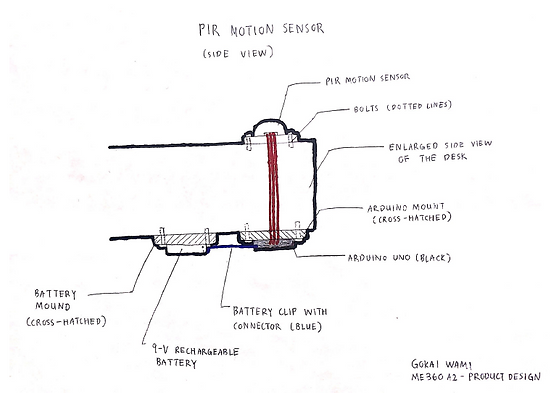Assignment #1 – Ideation: equipment for the classroom of the future
You are an undergraduate student at Boston University. As you arrive at your classroom one day, you are delighted to notice that a new measure made to prevent sleeping in class has been incorporated.
Video Source: BloodBlitz Comedy. (Producer). (2011, April 30). Episode 13: SLEEPING IN CLASS! [Video file]. Retrieved February 5, 2020, from
Problem Statement
On average, engineering students get 4.9 hours of sleep daily (Shukman). Early morning lectures can cause sleep-deprived students to doze off during class time and miss out on important information. However, tracking students' attention, especially in a large lecture hall of 90 students, would prove difficult and inefficient.
To ensure that students are alert during valuable lecture time, a solution should be created to motivate students to be attentive. By creating a product that would condition students to stay awake through different means, a sleep-free classroom environment can be achieved.
The total cost of this project would have to be under $100 per student, and done by a team of 4 students within 2 semesters.
Source: Shukman, H. (2017, October 27). New survey reveals the most sleep-deprived majors of 2017. Retrieved February 06, 2021, from https://thetab.com/us/2017/09/20/sleep-deprived-majors-71969
Most Suitable Prototype Design
The most suitable design is based on multiple factors in order to determine which prototype design works best. The constraints would need to be considered. A group of 4 students should be able to order, assemble, and implement the product into a classroom environment within a short time frame of 2 semesters. The product should be easy to use and require minimum effort. There should be some aesthetic value added from the product. Additionally, the bill of materials would ideally be as low as possible. Finally, other considerations such as the ethics, durability, and level of performance should be included. A Pugh chart can be created to observe how each product compares to one another.

Figure 1. Pugh Chart measuring the level of effectiveness for each prototype design in each of the aforementioned criteria. Points are assigned on a -1/0/+1 basis in which -1 is assigned to a detrimental aspect, 0 is assigned to a neutral, and 1 is assigned to a positive.
As shown in the Pugh Chart, the best prototype design by a stretch is the PIR Motion Sensor.
Participation in student set-up is not necessary (i.e. placing an elastic band on one's wrist) and the product does not affect comfort (i.e. hard to write because of the desk's angle). The aesthetics of the classroom would remain neutral since most of the hardwares would be installed underneath the desks so it is not visible. The time and level of knowledge needed to install the motion sensor into the school desks would not be as tedious or difficult as the pulse monitor watch, but still worse than the angle desk. An approximate cost estimate can be made for the product. Jumper wires costing no more than $0.03 a piece, most rechargeable batteries can be found under $1.00 a piece, an Arduino Uno Rev3 can be purchased wholesale for $23.00, and a PRI motion sensor from Newark can be obtained for under $3.00. All the needed mounting plates and bolts are relatively low cost as well and can be machined at the Boston University EPIC. The motion sensor is an ethical approach to capturing movement since no recording is needed and it does not affect students' ability to learn unlike the Angled desk which hinders student's ability to write or type because of the angle. According to Senglad, a typical battery powered motion sensor with LED lights can run for 22 years if not mistreated. Finally, assuming a 5-10m range and a proper code, the PRI Motion Sensor has an effective level of performance that could only be rivaled by the Pulse Monitor Watch. The problem with the Angled Desk in the performance criteria is that students can lean back on the chair to get shuteye or simply adapt to the desk.
Sources:
How long does the led with motion Sensor (SMARTSENSE) bulb last? (n.d.). Retrieved February 09, 2021, from https://support.sengled.com/hc/en-us/articles/219499357-How-long-does-the-LED-with-Motion-Sensor-Smartsense-bulb-last-
User's Behavior
In order to use the product efficiently, the product should be primarily incorporated into classrooms with early lecture times (8:00-10:00 am). When the students are aware of the PIR Motion Sensor, they will not have much of a choice. The product will be installed onto every desks in the classroom to avoid targeting and discrimination. Unlike a camera enforced system where students would need to give consent to be recorded and would feel uncomfortable because they are being watched, a PIR Motion Sensor wouldn't require such obligations. However, since students would be aware of the sensor, their behavior are subjected to change. For those who stay focused in class, no behavior change can be expected. The students who use the time to take a nap would be pressured and punished if their behavior does not change. Hopefully, with the addition of the PIR motion sensor, the students who typically sleep will get more rest before class, drink caffeine, or muster through the lecture until it is over. Otherwise, they face the consequences of getting points marked off their participation grade.


